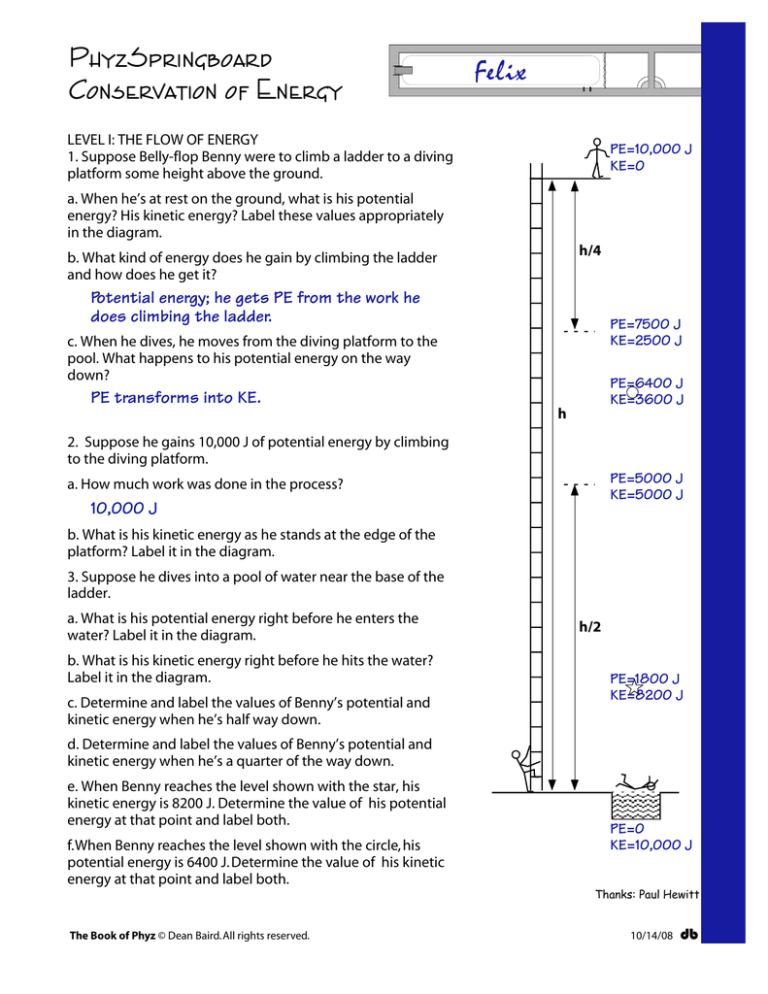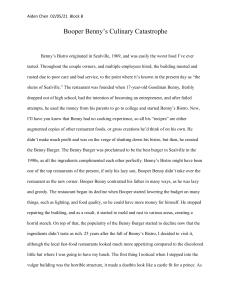
PhyzSpringboard
Conservation of Energy
Felix
LEVEL I: THE FLOW OF ENERGY
1. Suppose Belly-flop Benny were to climb a ladder to a diving
platform some height above the ground.
PE=10,000 J
KE=0
a. When he’s at rest on the ground, what is his potential
energy? His kinetic energy? Label these values appropriately
in the diagram.
h/4
b. What kind of energy does he gain by climbing the ladder
and how does he get it?
Potential energy; he gets PE from the work he
does climbing the ladder.
PE=7500 J
KE=2500 J
c. When he dives, he moves from the diving platform to the
pool. What happens to his potential energy on the way
down?
PE transforms into KE.
PE=6400 J
KE=3600 J
h
2. Suppose he gains 10,000 J of potential energy by climbing
to the diving platform.
PE=5000 J
KE=5000 J
a. How much work was done in the process?
10,000 J
b. What is his kinetic energy as he stands at the edge of the
platform? Label it in the diagram.
3. Suppose he dives into a pool of water near the base of the
ladder.
a. What is his potential energy right before he enters the
water? Label it in the diagram.
b. What is his kinetic energy right before he hits the water?
Label it in the diagram.
c. Determine and label the values of Benny’s potential and
kinetic energy when he’s half way down.
h/2
PE=1800 J
KE=8200 J
d. Determine and label the values of Benny’s potential and
kinetic energy when he’s a quarter of the way down.
e. When Benny reaches the level shown with the star, his
kinetic energy is 8200 J. Determine the value of his potential
energy at that point and label both.
f.When Benny reaches the level shown with the circle, his
potential energy is 6400 J. Determine the value of his kinetic
energy at that point and label both.
The Book of Phyz © Dean Baird.All rights reserved.
PE=0
KE=10,000 J
Thanks: Paul Hewitt
10/14/08
db
LEVEL II: MASS AND HEIGHT
4.Suppose g = 10 m/s2 and Belly-flop Benny has a mass of
100 kg.
a.What is the height of the diving platform? Hint: Consider
the equation for potential energy and solve it for h.
PE = mgh so
h = PE/mg = 10,000 J / 100kg · 10 m/s2 = 10 m
h/4
b.What’s the height of the circle?
h = PE/mg = 6400 J / 100kg · 10 m/s2 = 6.4 m
c.When Benny has a kinetic energy of 7700 J, what is his
height above the ground?
KE = E – PE = 10,000 J – 7700 J = 3300 J
h = PE/mg = 3300 J / 100kg · 10 m/s2 = 3.3 m
h
LEVEL III: SPEED
5.a.What is Belly-flop Benny’s impact speed when he hits
that water? Hint: Consider the equation for kinetic energy
and solve for speed.
KE = 1/2mv2 so
v = 2KE/m = 2·10,000 J / 100kg = 14 m/s
b.What is Benny’s speed when he’s half way down?
v = 2KE/m = 2·5000 J / 100kg = 10 m/s
c.When Benny has a potential energy of 8100 J, what is his
speed?
h/2
KE = E – PE = 10,00 J – 8100 J = 1900 J
v = 2KE/m = 2·1900 J / 100kg = 6.2 m/s
LEVEL IV: SPEED TO HEIGHT
6.When Benny is moving at 5 m/s, what is his height above
the ground? Hint: Determine his kinetic energy, then
potential energy, then height.
KE = 1/2mv2 = 0.5 · 100 kg · (5 m/s)2 = 1250 J
PE = E – KE = 10,000 J – 1250 J = 8750 J
h = PE/mg = 8750 J / 100 kg · 10 m/s2 = 8.8 m
LEVEL V: HEIGHT TO SPEED
7.When Benny is 2.4 m above the ground, what is his speed?
PE = mgh = 100 kg · 10 m/s2 · 2.4 m = 2400 J
KE = E – PE = 10,000 J – 2400 J = 7600 J
v = 2KE/m = (2 · 7600 J / 100 kg) = 12 m/s
The Book of Phyz © Dean Baird.All rights reserved.
EPILOG: BACK TO LEVEL I
8. After splashdown, Benny’s
potential energy and kinetic
energy are gone. Gone where?
To the water: splash and
warming; to the air: sound.
10/14/08
db


